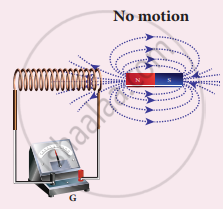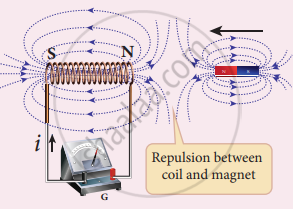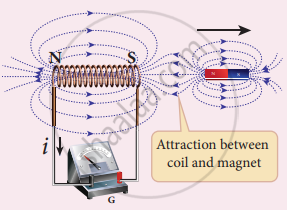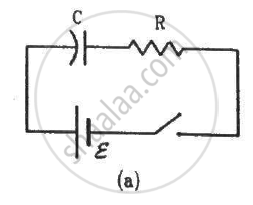Advertisements
Advertisements
प्रश्न
Give an illustration of determining direction of induced current by using Lenz’s law.
उत्तर
- Move the bar magnet towards the solenoid with north pole pointing solenoid.
- When the Magnetic flux increases in the coil, an induced current is produced, and the coil becomes a magnetic dipole.
- According to Lenz law, induced current opposes the movement of the north pole towards coil.
(a)
(b)
(c)
- It is possible if end nearer to magnet becomes the north pole, then it repels the north pole of the magnet and oppose the movement of the magnet.
- The direction of induced current is found by the right-hand thumb rule.
- When a bar magnet is withdrawn, the nearer end becomes south pole which attracts the north pole of the bar magnet, opposing the receding motion of the magnet.
7. Direction of induced current can be found from Lenz law.
APPEARS IN
संबंधित प्रश्न
A metal rod `1/sqrtpi `m long rotates about one of its ends perpendicular to a plane whose magnetic induction is 4 x 10-3 T. Calculate the number of revolutions made by the rod per second if the e.m.f. induced between the ends of the rod is 16 mV.
If ‘R’ is the radius of dees and ‘B’ be the magnetic field of induction in which positive charges (q) of mass (m) escape from the cyclotron, then its maximum speed (vmax) is _______.
A) `(qR)/(Bm)`
B)`(qm)/(Br)`
C) `(qBR)/m`
D) `m/(qBR)`
State the factors on which the strength of an electromagnet depends. How does it depend on these factors?
When current is 'switched on' and 'switched off' in a coil, a current is induced in another coil kept near it. What is this phenomenon known as?
Name and state the law which determines the direction of induced current.
or
State Fleming’s right-hand rule.
The switches in figure (a) and (b) are closed at t = 0 and reopened after a long time at t = t0.


(a) The charge on C just after t = 0 is εC.
(b) The charge on C long after t = 0 is εC.
(c) The current in L just before t = t0 is ε/R.
(d) The current in L long after t = t0 is ε/R.
Establish the fact that the relative motion between the coil and the magnet induces an emf in the coil of a closed circuit.
Ansari Sir was demonstrating an experiment in his class with the setup as shown in the figure below.

A magnet is attached to a spring. The magnet can go in and out of the stationary coil. He lifted the Magnet and released it to make it oscillate through the coil.
Based on your understanding of the phenomenon, answer the following question.
What will be observed when the Magnet starts oscillating through the coil. Explain the reason behind this observation.
A coil of one turn is made of a wire of certain length and then from the same length, a coil of two turns is made. If the same current is passed in both the cases, then the ratio of the magnetic inductions at their centres will be:
One solenoid is centered inside another. The outer one has a length of 50.0 cm and contains 6750 coils, while the coaxial inner solenoid is 3.0 cm long and π cm2 in area and contains 150 coils. The current in the outer solenoid is changing at 3000 A/s. The emf induced in the inner solenoid is ______ V.
(Round off to two decimal places.)
